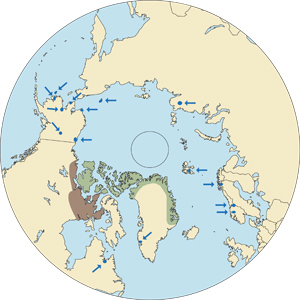 |
 |
Ovibos moschatus moschatus
Also called mainland muskox, or black-faced muskox.
DESCRIPTION Has a larger body and horns than the Greenland muskox, and tends to have a darker face, saddle, and lower legs.
DISTRIBUTION Until the late 1700s, barren ground muskoxen were found from Point Barrow, Alaska, eastward across the north slope of Alaska and Canada to Port Nelson, Manitoba (on Hudson Bay), and northward to include King William Island and the Boothia and Melville peninsulas. Subsequently exterminated in Alaska, and nearly so on the mainland of Canada, by whaling and sealing crews, trappers, and native people with modern firearms who hunted them for their meat and skins. Conservation efforts have allowed them to recover in many areas; however, their natural distribution is less extensive than before.
Today, barren ground muskoxen are found only in Canada, on the north slope of the mainland from about Cape Bathurst on the Beaufort Sea eastward to about Chesterfield Inlet on Hudson Bay, and southward to latitude 63°N between Artillery and Dubawnt lakes. The classification of the few muskoxen on King William Island is uncertain, but for record-keeping purposes we are considering them to be of the barren ground subspecies.
TAXONOMIC NOTES The so-called Hudson Bay, or Wager, muskox (niphoecus) from King William Island, the Boothia and Melville peninsulas, and the area bordered on the west by the Back River and on the south by Baker Lake and Chesterfield Inlet is no longer is considered a valid subspecies and is combined here with the barren ground muskox.
|





